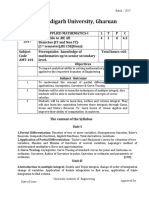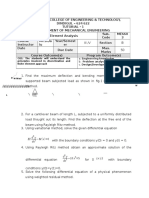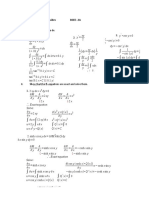Functions and Their Graphs
Functions and Their Graphs
Uploaded by
Mhamad HussenCopyright:
Available Formats
Functions and Their Graphs
Functions and Their Graphs
Uploaded by
Mhamad HussenOriginal Title
Copyright
Available Formats
Share this document
Did you find this document useful?
Is this content inappropriate?
Copyright:
Available Formats
Functions and Their Graphs
Functions and Their Graphs
Uploaded by
Mhamad HussenCopyright:
Available Formats
KOYA UNIVERSITY
Department: Civil Engineering Course Title: Mathematics I
Stage /Year: 1st Course Code: MAT5107
Functions And
Their Graphs
1. INTRODUCTION TO FUNCTIONS
Many scientific laws and engineering principles describe how one quantity depends on
another.
If a variable y depends on a variable x in such a way that each value of x determines exactly
one value of y, then we say that y is a function of x.
A function is a relation in which each element of the domain is paired with exactly one
element of the range.
In this notation, the symbol f represents the function, the letter x is the independent variable
representing the input value of f, and y is the dependent variable or output value of f at x.
Prepared by Assist. Prof. Sarkawt A. Saeed / 2020-2021
1
KOYA UNIVERSITY
Department: Civil Engineering Course Title: Mathematics I
Stage /Year: 1st Course Code: MAT5107
1. Find the domain and range of the following:
1. y= √ x +5 x +5 ≥0 x ≥−5 D y ≥0 R
1
2. y= x≠0 D y ≠0R
x
1
3. y= x≠7 D y ≠0R
x−7
4. y=| x| Allreal numbers D y ≥0 R
5. y= √3 x 2−4 D=R=all real numbers
6. y=x 3 D=R=all real numbers
7. y=−2 D= All Real Numbers R=−2
8. x 2+ y 2−3=0 x 2+ y 2=3 D=− √ 3 ≤ x ≤ √ 3 R=−√ 3≤ y ≤ √3
------------------------------------------------------------------------------------------------
2. GRAPH OF THE FUNCTIONS
Another way to visualize a function is its graph. If ƒ is a function with domain D, its
graph consists of the points in the Cartesian plane whose coordinates are the input-
output pairs for ƒ.
Cartesian plane (rectangular coordinate system)
Prepared by Assist. Prof. Sarkawt A. Saeed / 2020-2021
2
KOYA UNIVERSITY
Department: Civil Engineering Course Title: Mathematics I
Stage /Year: 1st Course Code: MAT5107
2. Sketch a graph of y=x 2−4 . −4 ≤ x ≤ 4
Solution:
x y
-4 12
-3 5
-2 0
-1 -3
0 -4
1 -3
2 0
3 5
4 12
------------------------------------------------------------------------------------------------
3. TRANSFORMATIONS OF FUNCTIONS
1. Vertical Shift
2. Horizontal Shift
3. Reflection
Prepared by Assist. Prof. Sarkawt A. Saeed / 2020-2021
3
KOYA UNIVERSITY
Department: Civil Engineering Course Title: Mathematics I
Stage /Year: 1st Course Code: MAT5107
------------------------------------------------------------------------------------------------
4. EVEN AND ODD FUNCTIONS
------------------------------------------------------------------------------------------------
3. Given y= √ x .
Graph 1. y= √ x−1 2. y= √ x +3 3. y= √ x−1 4. y= √ x +3
Solution:
4.
Determine whether each graph given in Figure is the graph of an even function, an odd
function, or a function that is neither
even nor odd.
Prepared by Assist. Prof. Sarkawt A. Saeed / 2020-2021
4
KOYA UNIVERSITY
Department: Civil Engineering Course Title: Mathematics I
Stage /Year: 1st Course Code: MAT5107
Solution:
2
1. y=x EVEN
2. y=x 2 +1 EVEN
3. y=x ODD
4. y=x +1 NEITHER EVEN NOR ODD
------------------------------------------------------------------------------------------------
5. TYPES OF FUNCTIONS
There are many different types of functions that can be used to model relationships observed
in the real world.
1. Linear
When we say that y is a linear function of x, we mean that the graph of the function
is a line, so we can use the slope-intercept form of the equation of a line to write a formula
for the function as y=f ( x )=mx+ b .Where m is the slope of the line and b is the y-intercept.
Prepared by Assist. Prof. Sarkawt A. Saeed / 2020-2021
5
KOYA UNIVERSITY
Department: Civil Engineering Course Title: Mathematics I
Stage /Year: 1st Course Code: MAT5107
5. You are driving on a road that has a 6% uphill grade (see figure). This means that the
slope of the road is 6/100. Approximate the
amount of vertical change in your position if you
drive 200 feet.
6 y
Solution: = → y =12 ft
100 200
------------------------------------------------------------------------------------------------
6. Find an equation of the horizontal line containing the point (3, 2).
Prepared by Assist. Prof. Sarkawt A. Saeed / 2020-2021
6
KOYA UNIVERSITY
Department: Civil Engineering Course Title: Mathematics I
Stage /Year: 1st Course Code: MAT5107
Solution: The equation of the horizontalline y=b , y=2
------------------------------------------------------------------------------------------------
7. Triangle ABC has vertice A (-6, 1), B (8, 9) and C (3,-5)
as shown. M is the mid-point of side AB and D is a point
on side AC.
a) Write down the coordinates of M.
b) Find the equation of MD given that MD is perpendicular
to side AC.
Solution:
a) M = ( 8−62 , 9+12 )=(1,5)
−5−1 −6 −2 3
b) mac = = = m MD=
3+6 9 3 2
3
y−5= ( x−1 )
2
------------------------------------------------------------------------------------------------
2
2. Quadratic Function f (x)=a x +bx +c
3. Cubic Function f ( x )=a x 3 +b x 2 +cx +d
N (x)
4. Rational Function f ( x )=
D( x )
5. Exponential Function
Prepared by Assist. Prof. Sarkawt A. Saeed / 2020-2021
7
KOYA UNIVERSITY
Department: Civil Engineering Course Title: Mathematics I
Stage /Year: 1st Course Code: MAT5107
General Form of Exponential Function
------------------------------------------------------------------------------------------------
Exponential functions decrease if 0 < a < 1 and increase if a > 1.
------------------------------------------------------------------------------------------------
8. Draw the graph of each function:
()
x
1
1. g ( x )=
3
x
2. f ( x )=3
Solution:
6. Natural Exponential
Function
Prepared by Assist. Prof. Sarkawt A. Saeed / 2020-2021
8
KOYA UNIVERSITY
Department: Civil Engineering Course Title: Mathematics I
Stage /Year: 1st Course Code: MAT5107
e=2.718281
------------------------------------------------------------------------------------------------
9. Sketch the graph of f ( x)=3 e0.5 x
Solution:
------------------------------------------------------------------------------------------------
7. Natural logarithm
Prepared by Assist. Prof. Sarkawt A. Saeed / 2020-2021
9
KOYA UNIVERSITY
Department: Civil Engineering Course Title: Mathematics I
Stage /Year: 1st Course Code: MAT5107
------------------------------------------------------------------------------------------------
10. Solve the following equation for x e 3 x =2
Solution:
Take ln each side ln e 3 x =ln 23 x=ln2 x=ln 2/ 3
------------------------------------------------------------------------------------------------
11. Sketch the graph of y=ln |x|
Solution:
8. Trigonometric Function
Angles
Prepared by Assist. Prof. Sarkawt A. Saeed / 2020-2021
10
KOYA UNIVERSITY
Department: Civil Engineering Course Title: Mathematics I
Stage /Year: 1st Course Code: MAT5107
------------------------------------------------------------------------------------------------
12. A circle has a radius of 4 inches. Find the length of the arc intercepted
by a central angle 240 ° of as shown in Figure
Solution:
------------------------------------------------------------------------------------------------
Right Triangle Definitions of Trigonometric Functions
Let be an acute angle of a right triangle. The six trigonometric functions of the angle are
defined as follows.
Trigonometric identities:
Prepared by Assist. Prof. Sarkawt A. Saeed / 2020-2021
11
KOYA UNIVERSITY
Department: Civil Engineering Course Title: Mathematics I
Stage /Year: 1st Course Code: MAT5107
------------------------------------------------------------------------------------------------
13. Use the triangle in Figure to find the values of the six
trigonometric functions
Solution:
------------------------------------------------------------------------------------------------
tanA +tanB
14. Prove that tan ( A+ B ) =
1−tanA tanB
Solution:
sinAcosB cosAsinB
+
sin( A+ B) sinAcosB +cosAsinB cosAcosB cosAcosB tanA +tanB
tan ( A+ B ) = = = =
cos( A+ B) cosAcosB−sinAsinB cosAcosB − sinAsinB 1−tanA tanB
cosAcosB cosAcosB
Prepared by Assist. Prof. Sarkawt A. Saeed / 2020-2021
12
KOYA UNIVERSITY
Department: Civil Engineering Course Title: Mathematics I
Stage /Year: 1st Course Code: MAT5107
Graphs of Trigonometric Functions
------------------------------------------------------------------------------------------------
15. Graph sec x−sin x tan x
Solution:
1 sinx 1−sin 2 x cos 2 x
−sin x = = =cosx
cosx cosx cosx cosx
------------------------------------------------------------------------------------------------
π π
16. Graph y=sin (x− 3 ) , y =sin (x + 6 )
Solution:
Prepared by Assist. Prof. Sarkawt A. Saeed / 2020-2021
13
KOYA UNIVERSITY
Department: Civil Engineering Course Title: Mathematics I
Stage /Year: 1st Course Code: MAT5107
9. Inverse Trigonometric Function
Inverse trigonometric functions arise when we want to calculate angles from side
measurements in triangles.
17.
Find
Prepared by Assist. Prof. Sarkawt A. Saeed / 2020-2021
14
KOYA UNIVERSITY
Department: Civil Engineering Course Title: Mathematics I
Stage /Year: 1st Course Code: MAT5107
−1 √ 3 −1 −1
(a) sin ( ¿)¿ (b) cos ( ¿ )¿ (c) cos (cos−1 ( √ 3 ¿ ¿ 2) ¿ (d) csc −1( √ 2 ¿ )¿
2 2
π 2π π
Solution: (a) (b) (c) √ 3/2 (d)
3 3 4
------------------------------------------------------------------------------------------------
18. Find the angle α .
Solution:
α =65−β=65−tan
−1
( 2150 )=42.22°
------------------------------------------------------------------------------------------------
10. Hyperbolic Functions
The hyperbolic functions are formed by taking combinations of the two exponential functions
ex and e -x. The hyperbolic functions simplify many mathematical expressions and occur
frequently in mathematical applications.
Prepared by Assist. Prof. Sarkawt A. Saeed / 2020-2021
15
KOYA UNIVERSITY
Department: Civil Engineering Course Title: Mathematics I
Stage /Year: 1st Course Code: MAT5107
Identities for hyperbolic functions
------------------------------------------------------------------------------------------------
19. Prove that cosh 2 x −sinh 2 x =1
Solution:
------------------------------------------------------------------------------------------------
20. Find (a) sinh(ln2) (b) sech(0)
Solution:
ln 2 1 1
e − ln 2 2−
e 2 3
( a ) sinh ( ln 2 )= = =
2 2 4
2 2
( b ) sech ( 0 )= = =1
0 1 2
e + 0
e
Prepared by Assist. Prof. Sarkawt A. Saeed / 2020-2021
16
KOYA UNIVERSITY
Department: Civil Engineering Course Title: Mathematics I
Stage /Year: 1st Course Code: MAT5107
Amplitude, Period and Phase Shift of Functions:
Example: Find Amplitude, Period and Phase Shift of function:
3
(
y= cos 2 x+
4
2π
3 )
Solution: Amplitude = A= ¾
2π 2π
Period of the function= period= B = 2 =π
π
Phase shift left= C= 3 to the left
Prepared by Assist. Prof. Sarkawt A. Saeed / 2020-2021
17
You might also like
- 1-2 SyllabusDocument5 pages1-2 SyllabusMallikarjunNo ratings yet
- Syllabus IBMDocument28 pagesSyllabus IBMManas KhareNo ratings yet
- CourseBook Math-I (2021 2022)Document5 pagesCourseBook Math-I (2021 2022)All TutorialNo ratings yet
- MTH111 Module1Document14 pagesMTH111 Module1Cluster 2, Cebu city, Josh C AgustinNo ratings yet
- SessionPlans Db99dMAT101 Syllabus & QBDocument14 pagesSessionPlans Db99dMAT101 Syllabus & QBNaitik TiwariNo ratings yet
- B Tech II Sem Syllabus of CSE ECE EEE Etc R16Document16 pagesB Tech II Sem Syllabus of CSE ECE EEE Etc R16ss mNo ratings yet
- KTU BTech EEE 2016scheme S3S4KTUSyllabusDocument41 pagesKTU BTech EEE 2016scheme S3S4KTUSyllabusleksremeshNo ratings yet
- B. Tech (CS) - 2010Document33 pagesB. Tech (CS) - 2010manjari09No ratings yet
- Assessment 2Document1 pageAssessment 2Carol Jane VillanoboNo ratings yet
- S3 Course HandoutDocument109 pagesS3 Course HandoutRanjan DhungelNo ratings yet
- Civil Engg - 2-1 SEM CS & Syllabus - UG - R20Document21 pagesCivil Engg - 2-1 SEM CS & Syllabus - UG - R20Sobha Ranjith KumarNo ratings yet
- Revised 1st Year Degree Syllabus of TitDocument28 pagesRevised 1st Year Degree Syllabus of TitGhagniSinghaniaNo ratings yet
- Syllabus Diploma Civil Lateral 2012-13Document64 pagesSyllabus Diploma Civil Lateral 2012-13iamaashuNo ratings yet
- K. J. Somaiya College of EngineeringDocument9 pagesK. J. Somaiya College of EngineeringSaraunsh JadhavNo ratings yet
- Q1 Bce 13 (A+b) Fa09Document1 pageQ1 Bce 13 (A+b) Fa09923315607508No ratings yet
- Scheme of Examination B.E. First Year (All Branches of Engineering) Second SemesterDocument23 pagesScheme of Examination B.E. First Year (All Branches of Engineering) Second SemesterAnita BhendeNo ratings yet
- Csvtu Syllabus Be Civil 3 SemDocument12 pagesCsvtu Syllabus Be Civil 3 SemMinendra Kumar ChandrakarNo ratings yet
- Syllabus - Mining Engineering - BE - III - Revised - 2013Document12 pagesSyllabus - Mining Engineering - BE - III - Revised - 2013virendra behraNo ratings yet
- Scheme - G Third Semester (Ej, Et, En, Ev, Ex, Is, Ic, Iu, De, Mu, Ie, Ed, Ei)Document39 pagesScheme - G Third Semester (Ej, Et, En, Ev, Ex, Is, Ic, Iu, De, Mu, Ie, Ed, Ei)digisagarNo ratings yet
- 121-B.Sc-M.E.CsDocument122 pages121-B.Sc-M.E.Csreddynithin1623No ratings yet
- Lecture Note On Chapter 13Document83 pagesLecture Note On Chapter 13Hồ Thanh DanhNo ratings yet
- A1 A3 A4 A5 1Q2425-C1-Practice-Problems-Integral CalculusDocument1 pageA1 A3 A4 A5 1Q2425-C1-Practice-Problems-Integral CalculuscharmaignemaegNo ratings yet
- Maths Sem 3Document352 pagesMaths Sem 3Piyush GoyalNo ratings yet
- Department OF Civil Engineering: I B.Tech (Civil Engineering) Course Structure & SyllabusDocument45 pagesDepartment OF Civil Engineering: I B.Tech (Civil Engineering) Course Structure & SyllabusvijayNo ratings yet
- Conceptual and Procedural Performance of Undergraduate Students in IntegrationDocument13 pagesConceptual and Procedural Performance of Undergraduate Students in IntegrationEndah Nawang WulanNo ratings yet
- Du Sol Major Math Sem 2Document156 pagesDu Sol Major Math Sem 2shivamshrm2831No ratings yet
- Pre-Requisites:: Engineering Mathematics - IiDocument14 pagesPre-Requisites:: Engineering Mathematics - IiSanjaykumar KmNo ratings yet
- EI D y DX M (X) 0 With The Boundary Conditions y (0) 0 and y (L) 0Document2 pagesEI D y DX M (X) 0 With The Boundary Conditions y (0) 0 and y (L) 0balusharma1212No ratings yet
- Experiment 1.3 Pde LabDocument4 pagesExperiment 1.3 Pde LabJayvardhan Singh TomarNo ratings yet
- B.Tech. I Year Syllabus Jntu HyderabadDocument32 pagesB.Tech. I Year Syllabus Jntu HyderabadIndra ReddyNo ratings yet
- Module 1 (Multivariable Calculus)Document141 pagesModule 1 (Multivariable Calculus)Vipul ThakurNo ratings yet
- B.tech Civil Curriculum Structure As Per NEP W.E.F 2023-24-1694930880Document30 pagesB.tech Civil Curriculum Structure As Per NEP W.E.F 2023-24-1694930880veceb64318No ratings yet
- 1st Year CseDocument33 pages1st Year Csemainak sahaNo ratings yet
- Maths Diploma Sem-1 SyllebusDocument73 pagesMaths Diploma Sem-1 Syllebuspruthavi.panchal.30No ratings yet
- ICCS2019 Ha V2Document14 pagesICCS2019 Ha V2princeyadav30082003No ratings yet
- Civil Engg 2013Document136 pagesCivil Engg 2013Balagopal VNo ratings yet
- Assignment 2 CS III SemesterDocument4 pagesAssignment 2 CS III SemesterdadhichsharmadivyaNo ratings yet
- Jawaharlal Nehru Technological University Hyderabad: B.Tech. I Year COURSE STRUCTURE & SYLLABUS (R18 Regulations)Document27 pagesJawaharlal Nehru Technological University Hyderabad: B.Tech. I Year COURSE STRUCTURE & SYLLABUS (R18 Regulations)Sai VardhanNo ratings yet
- B.tech Ist Year SyllabusDocument99 pagesB.tech Ist Year SyllabusdeekamittalNo ratings yet
- 12 MM Calculus SAC Part 1 - 2022Document12 pages12 MM Calculus SAC Part 1 - 2022cp cpNo ratings yet
- Telangana State Council of Higher EducationDocument28 pagesTelangana State Council of Higher EducationAmtech MubeenNo ratings yet
- TS SBTET C-18 DCE III Sem SyllabusDocument120 pagesTS SBTET C-18 DCE III Sem SyllabusSrinivas NaikNo ratings yet
- Assignment 1A NC LABDocument4 pagesAssignment 1A NC LABMuhammad Zubair NaeemNo ratings yet
- 1st Year Syllabus BMSDocument59 pages1st Year Syllabus BMStheseeker6323No ratings yet
- SE SyllabusDocument76 pagesSE SyllabusRohan TiwariNo ratings yet
- MTU 1 ST YEAR SYLLABUSDocument80 pagesMTU 1 ST YEAR SYLLABUSaditya7195488No ratings yet
- Assignment 1Document1 pageAssignment 1dipeshvadoliyaNo ratings yet
- Sem I Syllabus BSC (Hons. Physics)Document13 pagesSem I Syllabus BSC (Hons. Physics)Rizwan ChoudharyNo ratings yet
- Department of Physics Bsc. (Hons.) Physics: Discipline Specific Core Course - 1 (Dsc-1) Mathematical Physics IDocument96 pagesDepartment of Physics Bsc. (Hons.) Physics: Discipline Specific Core Course - 1 (Dsc-1) Mathematical Physics IHimanshu JoshiNo ratings yet
- JNTUA R20 B.Tech ECE Course Structure 20 21Document51 pagesJNTUA R20 B.Tech ECE Course Structure 20 21Srinath MNo ratings yet
- First Year Syllabii 2022 23Document24 pagesFirst Year Syllabii 2022 23Dknargesh 2003No ratings yet
- SyllabusDocument24 pagesSyllabusitachiuchihaop77No ratings yet
- Lecture Note Chapter 5Document68 pagesLecture Note Chapter 5Kham NguyenNo ratings yet
- Gen - Math Week3 - LM3Document10 pagesGen - Math Week3 - LM3Daryll FabrosNo ratings yet
- R18 B.tech I Year Syllabus of EEE CSE IT UpdatedDocument32 pagesR18 B.tech I Year Syllabus of EEE CSE IT UpdatedKrishna Teja NamuduriNo ratings yet
- Lesson 02.0Document12 pagesLesson 02.0Patrick Jamiel TorresNo ratings yet
- Jawaharlal Nehru Technological University Anantapur: First Year B.TechDocument51 pagesJawaharlal Nehru Technological University Anantapur: First Year B.TechSri Krishna GskdNo ratings yet
- R20-MFCS-2020-21 - QB-Mid-1Document4 pagesR20-MFCS-2020-21 - QB-Mid-1Sravani GunnuNo ratings yet
- Jntuk B.tech 1-1 r13 MechDocument23 pagesJntuk B.tech 1-1 r13 MechKonathala RajashekarNo ratings yet
- Logarithm EquationsDocument2 pagesLogarithm Equationsmisbachul.ardyNo ratings yet
- Chapter 3 Study GuideDocument4 pagesChapter 3 Study GuideDanny Shea O'BrienNo ratings yet
- Trigonometric FunctionsDocument10 pagesTrigonometric FunctionsEdi MuhammNo ratings yet
- Cauchy RiemannDocument6 pagesCauchy RiemannSyed Abdul Rehman ShahNo ratings yet
- TTDocument30 pagesTTAdrian CamachoNo ratings yet
- TopSolid'WoodCam Processes Operators - USDocument1 pageTopSolid'WoodCam Processes Operators - USheron1000No ratings yet
- Unit Iii Analytic Functions Part-A: Problem 1 SolutionDocument17 pagesUnit Iii Analytic Functions Part-A: Problem 1 SolutionSriram JNo ratings yet
- Grade 11 Math Exam NotesDocument13 pagesGrade 11 Math Exam Notespkgarg_iitkgpNo ratings yet
- Mth631-Real Analysis 2 Merged Lecher (20-23-25) by PinDocument183 pagesMth631-Real Analysis 2 Merged Lecher (20-23-25) by PinAbdul RehmanNo ratings yet
- Homework 2Document4 pagesHomework 2Abegail LorillaNo ratings yet
- 23.11.03 Friday Ratio and Root TestsDocument5 pages23.11.03 Friday Ratio and Root Testsiyanjohn007No ratings yet
- Indices and SurdsDocument26 pagesIndices and SurdsS. M.No ratings yet
- W s-12 Trigonometric RatiosDocument3 pagesW s-12 Trigonometric Ratiosapi-253679034No ratings yet
- Homework Chapter 6 Logarithmic DifferentiationDocument4 pagesHomework Chapter 6 Logarithmic DifferentiationAñxiêty AêsthetiçsNo ratings yet
- Math 7 q2 12 Illustrating Different Subsets of Real Numbers With QuizDocument25 pagesMath 7 q2 12 Illustrating Different Subsets of Real Numbers With Quizxanxus1315No ratings yet
- Indefinite Integral PartDocument6 pagesIndefinite Integral PartSaisriram KarthikeyaNo ratings yet
- Differentiation Definition: Let: y FX Ab FXDocument25 pagesDifferentiation Definition: Let: y FX Ab FXRazvan Gabriel RizeaNo ratings yet
- Lab Report No. 10: Signals& Systems EEE-223Document9 pagesLab Report No. 10: Signals& Systems EEE-223Tayyab AhmedNo ratings yet
- 1.1 Trig Ratios in Right Triangles Part 1Document5 pages1.1 Trig Ratios in Right Triangles Part 1Adam MikitzelNo ratings yet
- Assignment in Algebra and TrigoDocument14 pagesAssignment in Algebra and TrigoDaryl Anne NolascoNo ratings yet
- Improper IntegralDocument10 pagesImproper IntegralSAURAV ROYNo ratings yet
- 100 Derivatives and Integrals ExerciseDocument5 pages100 Derivatives and Integrals Exercisedikox75208No ratings yet
- Maths Holiday HomeworkDocument7 pagesMaths Holiday HomeworkDON'T CRAMNo ratings yet
- Chapter 9: Trigonometry 11: Important Concepts: Trigonometrical RatiosDocument22 pagesChapter 9: Trigonometry 11: Important Concepts: Trigonometrical RatiosLau Yong HuiNo ratings yet
- Clausen Hypergeometry IdentityDocument6 pagesClausen Hypergeometry IdentityPapy MaikaNo ratings yet
- CH 8 - Trigonometry Class XDocument2 pagesCH 8 - Trigonometry Class XCRPF SchoolNo ratings yet
- Pre Cal PetaDocument8 pagesPre Cal PetaJhames HarveyNo ratings yet
- Series FormulasDocument3 pagesSeries FormulasBachchan MishraNo ratings yet
- Sine Ambig CaseDocument9 pagesSine Ambig CaseJan Leynard ParraNo ratings yet
- Chapt 7 - Trigonometry PDFDocument46 pagesChapt 7 - Trigonometry PDFNely JayNo ratings yet

























































































